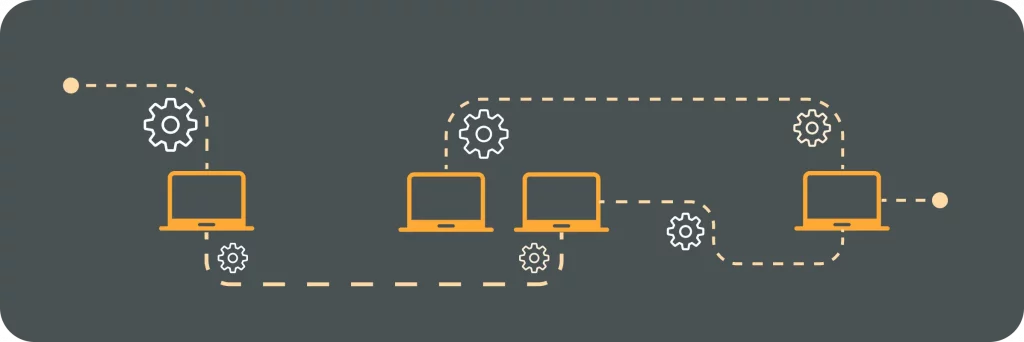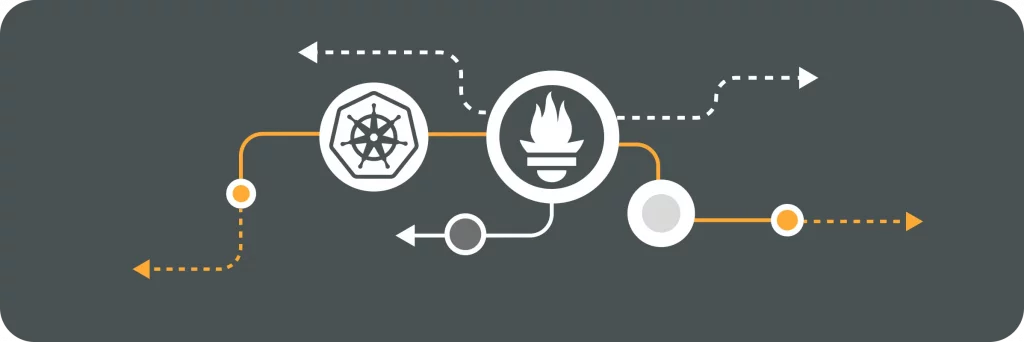Jaeger is a distributed tracing system that plays a crucial role in the world of DevOps. It offers powerful capabilities for monitoring and troubleshooting applications, enabling developers to gain deep insights into the performance and behavior of their systems. In this article, we will explore the basics of Jaeger, its key features, architecture, benefits, and how it can be integrated with other DevOps tools.
Understanding the Basics of Jaeger
If you’re new to Jaeger, let’s start with a definition. Jaeger is an open-source, end-to-end distributed tracing system that helps monitor and troubleshoot complex applications in cloud-native environments. It provides a comprehensive view of requests as they flow through multiple microservices, enabling developers to pinpoint performance bottlenecks and identify areas for optimization.
Jaeger accomplishes this by instrumenting your code to collect trace data, which includes information about the timing and dependencies of various components within your application. This data is then sent to a central Jaeger server for storage and analysis. The intuitive user interface of Jaeger allows developers to visualize the trace data in a way that makes it easy to identify issues and improve performance.
Definition of Jaeger
In simple terms, Jaeger is a tool that allows you to trace the execution path of requests as they pass through different components of your application. By capturing and visualizing the flow of requests, Jaeger helps you understand how your application behaves under real-world conditions.
Furthermore, Jaeger supports various storage backends such as Elasticsearch, Cassandra, and Kafka, giving users the flexibility to choose the most suitable option based on their specific requirements. This adaptability makes Jaeger a versatile tool that can seamlessly integrate into different infrastructures and workflows.
The Role of Jaeger in DevOps
In the world of DevOps, where agility and scalability are paramount, Jaeger plays a vital role. It provides developers with the necessary visibility to monitor and troubleshoot their applications in complex distributed systems. By identifying performance bottlenecks and analyzing dependencies, Jaeger empowers teams to optimize system performance and deliver a better end-user experience.
Moreover, Jaeger’s integration with popular DevOps tools such as Kubernetes and Prometheus enhances its capabilities by enabling seamless data sharing and correlation. This interoperability ensures that Jaeger can fit seamlessly into existing DevOps workflows, streamlining the monitoring and troubleshooting processes for development teams.
Key Features of Jaeger
Now that we have a basic understanding of Jaeger, let’s dive into its key features:
Tracing Capabilities
Jaeger’s primary feature is its distributed tracing capabilities. It allows developers to trace the complete lifecycle of a request as it propagates through various microservices. With detailed traces, developers can gain insights into latency, errors, and dependencies, enabling them to identify and resolve performance issues efficiently.
Furthermore, Jaeger’s tracing capabilities extend beyond just monitoring individual requests. It also provides a holistic view of the entire system’s performance, allowing developers to understand how different services interact with each other and impact overall performance. This comprehensive tracing functionality is invaluable for troubleshooting complex issues in distributed systems.
Performance Optimization
Jaeger helps optimize the performance of your applications by providing visibility into the execution path of requests. By analyzing traces, developers can identify performance bottlenecks and areas of improvement, enabling them to optimize the system for better performance and scalability.
In addition to performance optimization, Jaeger offers real-time monitoring and alerting features that empower developers to proactively address performance issues before they impact end-users. By setting up custom alerts based on specific performance thresholds, teams can ensure that their applications consistently meet performance expectations.
The Architecture of Jaeger
Now let’s take a closer look at Jaeger’s architecture:
Jaeger is an open-source, end-to-end distributed tracing system used for monitoring and troubleshooting microservices-based distributed systems. Its architecture is designed to provide developers with insights into the flow of requests and responses across various services.
Components and Their Functions
Jaeger consists of multiple components that work together to provide tracing capabilities. The key components include:
- Jaeger Agent: Collects and forwards tracing data to the Jaeger Collector
- Jaeger Collector: Receives tracing data from agents, validates and prepares it for storage
- Jaeger Storage: Stores and indexes traces for querying and analysis
- Jaeger Query: Provides a user interface for querying and analyzing traces
- Jaeger Ingester: Responsible for ingesting traces from the Jaeger Agent and persisting them to storage
Each component plays a crucial role in the overall functioning of Jaeger’s tracing system. The Jaeger Ingester, for example, ensures that all incoming traces are reliably stored and indexed for future analysis.
Understanding the Workflow
The workflow of Jaeger can be summarized in the following steps:
- Instrumentation: The code of the application is instrumented to capture traces
- Trace Capture: The instrumented code captures traces as requests flow through the system
- Trace Forwarding: The traces are forwarded to the Jaeger Agent
- Trace Storage: The Jaeger Agent sends the traces to the Jaeger Collector for storage and indexing
- Trace Analysis: Developers can query and analyze the traces using the Jaeger Query user interface
- Alerting: Jaeger can be configured to trigger alerts based on predefined conditions, allowing teams to proactively address performance issues
By following this workflow, developers can gain valuable insights into the behavior and performance of their applications. The addition of alerting capabilities ensures that any anomalies or deviations from expected behavior are promptly identified and addressed.
Benefits of Using Jaeger in DevOps
Now, let’s explore the benefits of using Jaeger in the DevOps ecosystem:
Improved Monitoring
Jaeger provides real-time visibility into the execution path of requests, allowing developers to monitor their applications more effectively. With detailed traces, it becomes easier to spot anomalies, errors, and performance bottlenecks, enabling proactive monitoring and faster issue resolution.
Efficient Troubleshooting
When issues arise, troubleshooting can be a daunting task in complex distributed systems. Jaeger simplifies this process by providing a unified view of the flow of requests. Developers can quickly identify the source of errors and bottlenecks, leading to faster troubleshooting and resolution.
Enhanced Scalability
One of the key advantages of incorporating Jaeger into DevOps practices is its ability to scale seamlessly with growing infrastructure demands. As applications expand and user bases increase, Jaeger’s distributed tracing capabilities ensure that performance monitoring remains efficient and reliable. This scalability feature allows DevOps teams to maintain visibility and control over their systems regardless of size or complexity.
Streamlined Performance Optimization
Jaeger not only aids in monitoring and troubleshooting but also plays a crucial role in optimizing the performance of applications. By analyzing trace data, developers can pinpoint areas of code that require optimization or restructuring to enhance overall efficiency. This proactive approach to performance tuning helps DevOps teams fine-tune their applications for optimal speed and resource utilization, ultimately leading to a better user experience.
Integrating Jaeger with Other DevOps Tools
Incorporating Jaeger into your existing DevOps toolchain can greatly enhance your system’s monitoring and observability capabilities. Jaeger, an open-source distributed tracing system, allows you to track and analyze the performance of your applications in real-time. Let’s delve deeper into how Jaeger can seamlessly integrate with other essential DevOps tools to provide a holistic view of your system’s health and performance.
Compatibility with DevOps Tools
Jaeger is specifically designed to work harmoniously with a variety of popular observability and logging tools, including Prometheus, Grafana, and the ELK stack (Elasticsearch, Logstash, Kibana). By integrating Jaeger with these tools, you can consolidate tracing data with other crucial metrics, logs, and events. This correlation enables you to gain a comprehensive understanding of your system’s behavior, identify bottlenecks, and troubleshoot performance issues effectively.
Steps to Integration
Integrating Jaeger with your existing DevOps tools involves a series of straightforward steps to ensure a smooth and efficient process:
- Begin by installing Jaeger components and configuring them to collect traces from your applications.
- Next, enable instrumentation in your application code to capture detailed traces of requests as they traverse through various services.
- Configure Jaeger to export these traces to your preferred observability tool, such as Prometheus or Grafana, for further analysis and visualization.
- Finally, set up custom visualizations and dashboards within your chosen tool to monitor key performance indicators and track the overall health of your applications.
By diligently following these integration steps, you can seamlessly embed Jaeger’s powerful tracing capabilities into your DevOps workflow, empowering your team to proactively monitor, analyze, and optimize the performance of your applications.
Conclusion
In conclusion, Jaeger is a valuable tool in the DevOps arsenal, providing distributed tracing capabilities that enable developers to monitor and troubleshoot complex applications effectively. With Jaeger’s comprehensive view of request flows, teams can optimize performance, improve troubleshooting efficiency, and seamlessly integrate with other DevOps tools. By leveraging Jaeger, you can enhance your application’s observability and deliver a better user experience.




